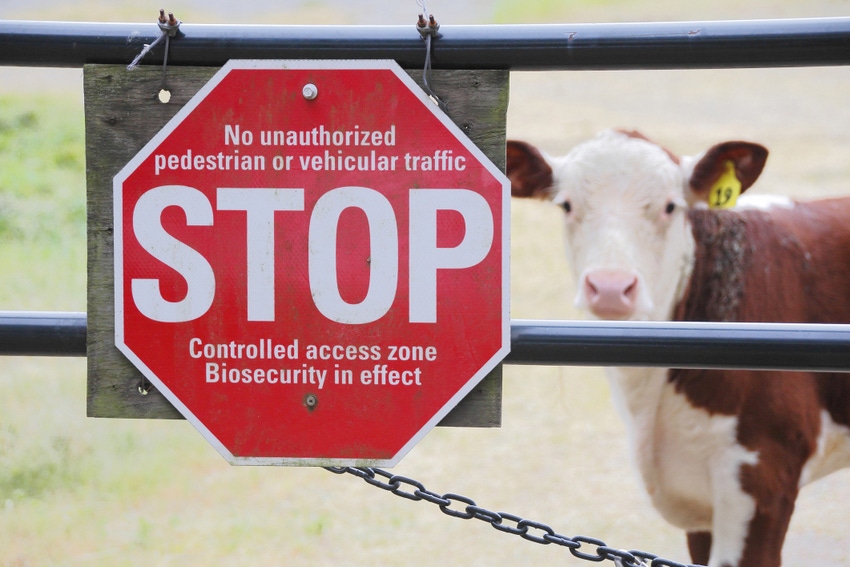- Livestock & Poultry Market news
- Nutrition & Health
- Beef Health and Nutrition
- Dairy Health and Nutrition
- Swine Health and Nutrition
- Poultry Health and Nutrition
Discussions included topics on transboundary animal disease threats to U.S. agriculture, U.S.-border agriculture inspections, wildlife/vector/livestock dynamics and workforce development needs.
October 21, 2019

In order to better protect U.S. agriculture, economy and rural and urban communities from increasing global infectious diseases and pathogen threats, Texas A&M AgriLife and Texas A&M Division of Research recently hosted a consortium of universities, state animal health officials, private sector organizations and federal government representatives for a two-day meeting.
The goal of the meeting was to identify priority gaps that require collaborative research and practical solutions, Texas A&M AgriLife said in an announcement.
The group included the Coalition for Epi Response, Engagement & Science (CERES), which is a consortium of land grant universities including Colorado State University, the University of California-Davis, Kansas State University, Iowa State University, the University of Nebraska-Lincoln and the University of Nebraska Medical Center. CERES works to integrate the strengths and assets of these universities and stakeholders to create new opportunities, ideas and practices through collaborative engagement.
From genomics to vector-borne diseases to laboratories and national borders, the topics examined covered the most prevalent issues facing infectious disease outbreaks in animals and plants. Discussions included topics on transboundary animal disease threats to U.S. agriculture, U.S.-border agriculture inspections, wildlife/vector/livestock dynamics and workforce development needs. Tick-borne diseases such as babesiosis and African swine fever showcased how attendees could work together, the announcement said.
“Producers appreciate the collaboration and communication with these entities for research, preparedness and response efforts for disease control,” said Lisa Becton, director of swine health information and research at the National Pork Board.
“We are honored to work with those who are most directly impacted by animal and plant diseases and those who work daily to keep transboundary pathogens and threats from entering the U.S.,” said Dr. Patrick Stover, vice-chancellor of Texas A&M AgriLife, dean of the College of Agriculture & Life Sciences and director of Texas A&M AgriLife Research. “This is a team effort, no one group can do this on our own. This teamwork requires basic and applied research, training and innovative solutions to meet today’s and future needs. We are, quite simply, stronger together.”
Meeting participants included animal health companies, livestock associations, state animal health officials, extension, federal research and animal health entities, laboratories and research facilities. The group used the meeting to highlight successful current collaborations and to create focused “next steps” for collaborative action on how to better prevent, plan and respond to infectious disease threats, according to the announcement.
Texas A&M AgriLife said one of the most important aspects of the meeting included collaborations with agricultural organizations such as the Texas & Southwestern Cattle Raisers, the National Pork Board, the National Milk Producers Federation, the American Feed Industry Assn., the Texas Animal Health Commission and the U.S. Department of Agriculture’s Animal & Plant Health Inspection Service and Agriculture Research Service and U.S. Customs & Border Protection.
“Effective disease prevention and eradication programs are based on sound science,” said Dr. Andy Schwartz, executive director of the Texas Animal Health Commission and Texas state veterinarian. “Research is a tool that creates and fosters new, alternative and improved methods for fighting and protecting Texas livestock from both emerging disease threats, such as African swine fever, and historical diseases and pests such as bovine tuberculosis and cattle fever ticks.”
The CERES consortium plans to work together on projects to address priority gaps discussed during the meeting and to continue discussions with the wide range of stakeholders in U.S. agriculture and those involved in efforts to protect this sector so vital to the nation’s economy, food security and the global community, the announcement added.
Source: Texas A&M AgriLife, which is solely responsible for the information provided and is wholly owned by the source. Informa Business Media and all its subsidiaries are not responsible for any of the content contained in this information asset.
You May Also Like
.png?width=300&auto=webp&quality=80&disable=upscale)
.png?width=300&auto=webp&quality=80&disable=upscale)

